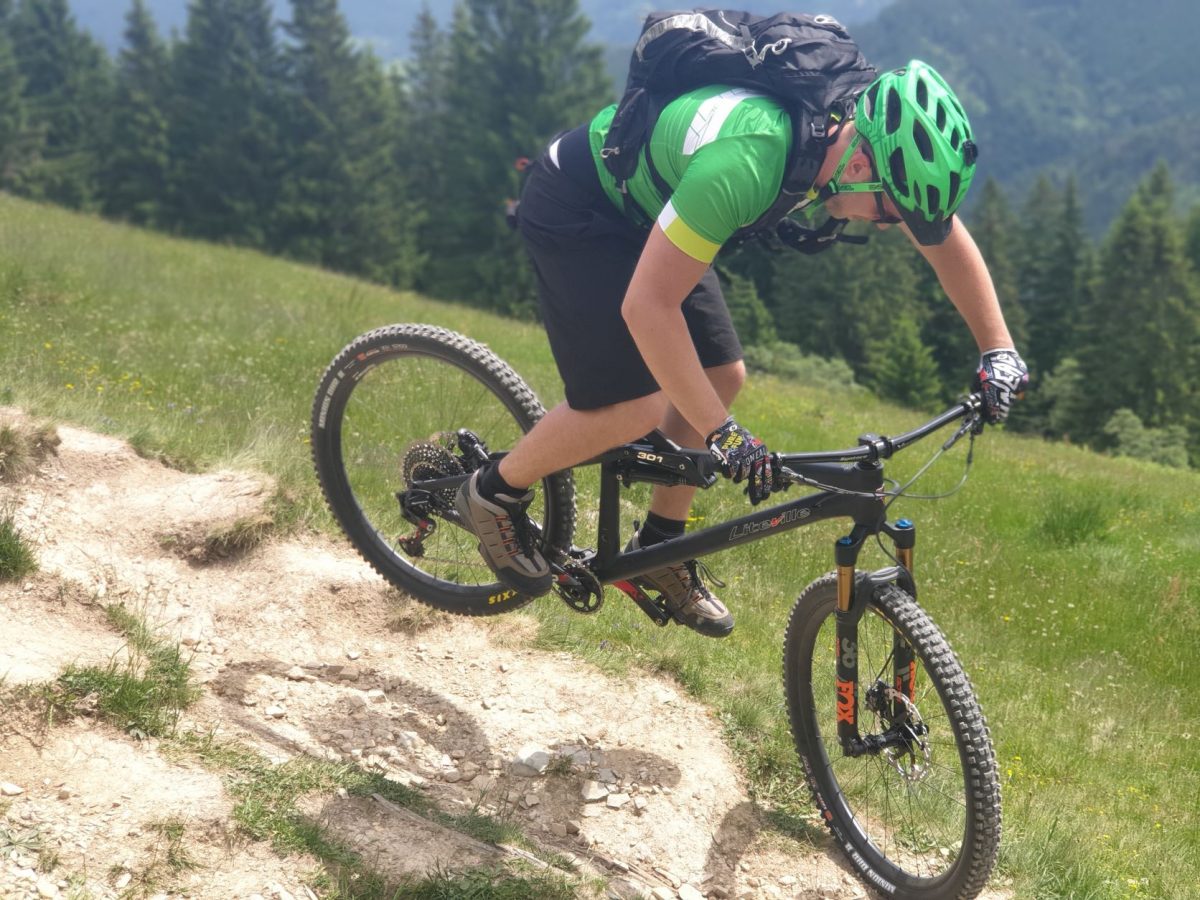Only when you feel safe on your mountain bike can you enjoy biking. That’s why technical exercises are a crucial factor: you can ride more challenging tours, and in the race you save valuable seconds. The following exercises will help you develop the technical skills to ride safely and confidently.
Crossing obstacles
Roots, tree trunks lying across or water gullies: You have to prepare for such situations already in training. It is important not to panic in the face of such obstacles and not to stiffen up. If it’s dry, you can ride over roots normally, lifting the handlebars a little to take the weight off the front wheel. Wet roots are more treacherous. Then it is advisable to approach the root at a right angle. Otherwise the front wheel slips away.
If you want to practice riding over roots very slowly, you can choose a gentle slope with roots and select a light gear. The front wheel is already relieved by the slope, you roll almost by itself over the root. With larger obstacles, you also have to coordinate the pedaling motion with going over them: The pedal of the stronger foot is up, while you gain momentum with your upper body, pull up the handlebars with a jerk from your arms and make a pedaling motion at the same time. Once the obstacle is crossed, you have to stand up and pull the rear wheel up. The more elegant version is to jump over the obstacle with the mountain bike: To do this, you have to start at a higher speed, pull up the handlebars with more momentum and pull the rear wheel along.
Picking up an object from the ground
To practice balance on the mountain bike, picking up an object from the ground works well. If there are two of you, the person in front can put his water bottle on the ground and the person behind can pick it up. To do this, unclick the foot opposite the obstacle from the pedal and put your hand on the brake lever. Just before the object, bend the upper body and stabilize with the opposite leg unclicked, stretching it.
Slalom and tight cornering
An important exercise is making tight turns. This is especially easy to practice by trying to drive as tightly as possible around a tree. The important thing here is to not stop pedaling and to let both brakes drag slightly. If it works on one side, practice the other right away. However, it is normal to have a better grip on one direction than the other. The more difficult version is riding a slalom track. Using branches, you lay out a course on a slight incline. When going uphill, it is important to shift your weight well. When going downhill, you have to make sure that the pedal position is correct: The pedal inside the curve must always be up. To change sides, make a forward pedaling motion.
Ascent and descent
When an ascent is in sight, choose an easy gear. The majority of longer climbs are ridden in the saddle. This saves energy compared to out of the saddle pedaling. By pushing and pulling both legs evenly, you practice optimal power transfer to the pedals. It is important to put enough weight on the rear wheel, otherwise it will spin. If the front wheel lifts, the center of gravity should be shifted slightly forward so that the rear wheel is still sufficiently loaded. The position of the body’s center of gravity is very important on descents with increasing gradients and on difficult surfaces. The buttocks should be shifted very far back, the gaze should be directed forward, the legs should be horizontal in the pedals and the front brake should be used extremely sparingly. In plain language: the buttocks belong behind the saddle. If you use the front brake too much, it will most likely end in a crash.
Wheelie
The wheelie requires some skill and a lot of patience. The best way to practice it is on an easy climb: your stronger foot is up, your upper body is over the handlebars, and the rear brake is applied. The moment the mountain bike comes to a stop, release the rear brake and pedal. The front wheel should then rise automatically without you having to pull it up with force. Now you just have to keep your balance and keep pedaling steadily. One finger always remains on the rear brake so that you don’t go too fast. A preliminary stage of the Wheelie is this partner exercise: The biker is pulled up from behind by a second person and supported. In this way, the practitioner quickly feels where the highest point is at which he or she can still ride.
Drifting
A good exercise to find out how the bike reacts in extreme situations is drifting. By completely locking the rear wheel, the bike slides around the corner. The drift is triggered by firmly pulling the rear brake and shifting weight to the side you want to drift to. When drifting, you lose speed and ruin the surface. Drifting, also called sliding, is therefore not a cornering technique, but merely a way to get to know and feel the mountain bike. At higher speeds, you can take the foot inside the curve off of the pedal for stabilization.
This Blog Article was made available to us by Fit for Life. Fit for Life is the Swiss magazine for fitness, running and endurance sports. Would you like to read such articles regularly? Then Click here.

Perhaps this interests you too: Smooth Pedaling or
